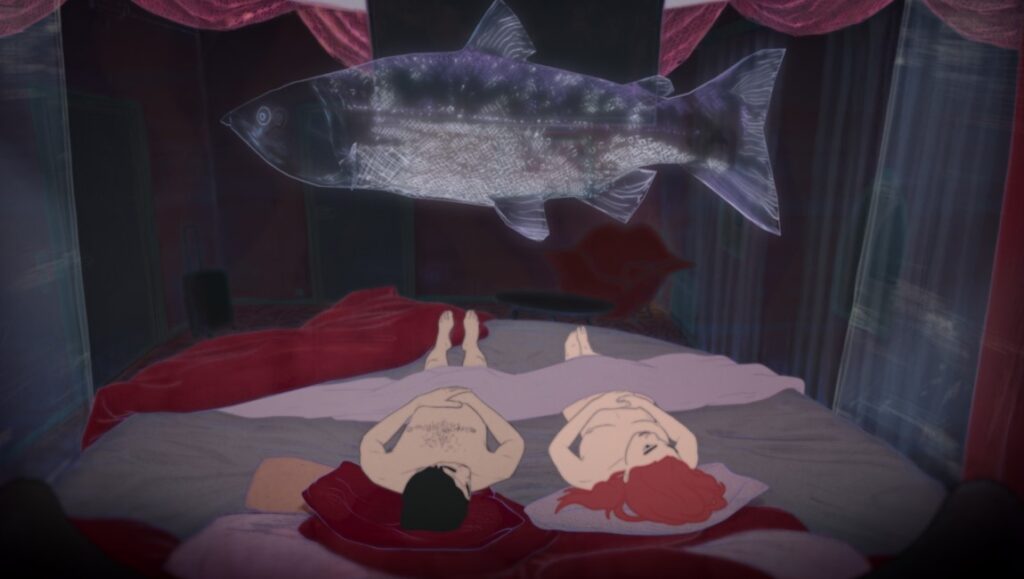The first thing one is likely to notice about Blind Willow, Sleeping Woman is how ugly its characters look. Their eyes are empty of that glimmer of light that brings animation or a painting to life, their faces totally devoid of detail except for the lines that come with age. First-time feature director Pierre Földes used quite a strange method to achieve this: live actors are rotoscoped, animation is drawn on top of their performances, and then a 3D model replaces the head, on which the face is animated in 2D. On some level, this works: an adaptation of a handful of Haruki Murakami short stories, the film is tied together by its focus on two characters who share the same bleak and inexpressive office space. Though in another sense, the choice of drawing the background characters as almost ghosts, spectral in their light transparency and mostly featureless renderings, is strange, as the main ones look more than dead enough already.
Katagiri, in particular, seems to have long ago given up on life; he’s put-upon by a colleague, who always leaves a pile of their own work on his desk. He’s much too timid to ever seek recognition for picking up the slack of his colleague — and it doesn’t seem like it would give him any sense of fulfillment, even if he did. Elsewhere in the same office, Komura — a quintessential Murakami protagonist — is told that his job will soon be eliminated. Making matters worse, Komura’s wife has recently left him, seemingly fed up with his obsessing over the 2011 Tōhoku Earthquake, and he now spends most of his time wandering around feeling sorry for himself without ever thinking too deeply about why she left. His wife’s final words do, however, echo in Komura’s mind: “Living with you is like living with a chunk of air.” Viewing this type of character from the outside, rather than getting a sense of their interiority — as tends to be the case with most Murakami writing — makes them seem particularly unappealing and nasty. Komura may be self-loathing, but not because of any recognized flaws or shortcomings as a person or a husband; instead, he perceives his pitiable state as due to vague existential conditions of modern living, like emptiness — i.e., things that are out of his control, and thus not his fault.
Komura’s issues with women, specifically his disinterest in conceptualizing them, reach beyond his character and into the fabric of Murakami’s work — it’s probably the most famous thing about the author these days — and Földes is loyal to that vision. The best that could be said of this is that Murakami struggles openly, that he lays bare the process of misogyny, at least in a certain type of man, which is true of some truly great art like Hitchcock’s Vertigo, though probably to a lesser extent. That comparison certainly feels strained in the section of the movie where Komura goes to Hokkaido to deliver a package that he doesn’t know the contents of and meets two women, one of whom he ends up sleeping with and then fantasizes about killing when she jokes that his soul is the package he’d delivered. This isn’t limited to the source material either: when the two women laugh at an inside joke Komura isn’t in on, they are depicted on screen as truly grotesque — whether this is a coincidence of the animation style or executed with cutting purpose is unclear.
The film’s best sequence happens when Kyoko, Komura’s ex, suddenly reappears, long after it seems like she’d vanished into pure narrative motivation for Komura’s self-pitying melancholy. The scene is a fairly down-the-line adaptation of Murakami’s “Birthday Girl,” which works especially well on the page because it’s just an accumulation of strange, though not fantastical, details. The virtue of Murakami’s prose comes from its easy readability, which creates an interesting effect when describing something surreal; the bizarre and mundane married. This doesn’t translate well to film, however, because it’s hard to make, say, a giant frog feel natural and unassuming when it’s realized visually. Földes clearly understands he needs to deviate, which he does by placing more emphasis on mood, utilizing, for example, the soundtrack’s spare, ominous piano and quietly throbbing synths. But staying so loyal to the source material means this can flourish only according to its own, isolated virtues.
Blind Willow, Sleep Woman ends up feeling hamfisted whenever it reaches toward profundity, in a similar way that Murakami’s work can, but without that same elusiveness; Murakami’s themes are filtered through people unable to articulate them (maybe he himself is among them), and this allows some space for light to move through, for real meaning to fill the emptiness. Földes does find a means to emulate this in the way he gently threads these disparate stories together, but while the characters offer connective tissue, nothing here ever meaningful coheres, their relationships slightly vague. This doesn’t amount to much for Katagiri, whose final scenes seem oddly optimistic, with career development blandly paralleling personal growth. But for Komura, amidst the fog of his narcissism, there seems to be something there. What’s less clear is if it’s anything of all that much value.
Published as part of InRO Weekly — Volume 1, Issue 15.


Comments are closed.